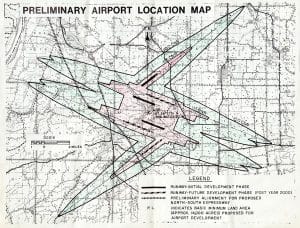Monroe County 1960-80: what might have been

Courtesy of Dennis Knobloch, who found this map at an auction, this map of the proposed Waterloo-Columbia Airport shows the airport and surrounding property that would likely have been highly restricted due to the predicted volume of air traffic. (submitted photo)
(This is the next monthly installment of our series looking into the 200-year history of Monroe County in honor of its Bicentennial. This article examines the years 1960 to 1980.)
The 1960s and 1970s were marked by several historic events, much uncertainty, and the stops and starts of big plans.
County history enthusiast Dennis Knobloch – who has helped greatly with this series of history articles – characterized it as a time of “things that might have been.” The events are difficult to place in chronological order – as many spanned years.
The 1960 county census was at 15,507 residents, down 1,600 from the 1950s number. But by 1980, there were 20,117 citizens, with explosive residential subdivision developments countywide. Some of that was in old Valmeyer, before flood plain rules and regulations were introduced.
As the county left the late 1950s, a major effort was underway to build a Mississippi River bridge between Harrisonville and Herculaneum, Mo. A ferry, dubbed the “Herky Ferry,” had followed that route from 1936 to 1943, when World War II fuel rationing brought its operation to an end.
In the early 1960s, a society formed to champion the bridge project, selling memberships for $25 apiece. It was hoped by many the proposed bridge would cause a surge of development in the county, especially in the bottoms. The project died not much later when it became obvious there was no federal or state funding to support the expensive effort.
Uncertainty and national anxiety were heightened nationwide in the 1960s, as the country was rocked by three high-profile assassinations. The uncertainty was perhaps similar to what is experienced today with the nation’s constant alert for terror attacks.
President John F. Kennedy was assassinated Nov. 22, 1963. The Rev. Martin Luther King was killed April 4, 1968, and presidential candidate and brother of John Kennedy, Robert Kennedy, was gunned down June 5, 1968, while campaigning in California. Like today, many wondered when and where it would happen next.
The era generated more uncertainty among the young men of the county, as draftees were taken into the military services to fight in Vietnam. Uncertainty was further created when the U.S. embarked on a “draft lottery,” with birthdates being picked from a shoe box for the 366 days of 1970.
The first number drawn was 258, which meant persons born Sept. 14 – the 248th day of the year – were subject to immediate draft. We don’t know for sure who from Monroe County was the first person to draw the “short straw” in the draft lottery.
Two positive events were celebrated in 20 years time.
In 1966, Monroe County celebrated its 150th anniversary – a “Sesquicentennial” – that is being paralleled by this year’s Bicentennial celebration. Like this year, there were wheat cutting and threshing demonstrations. There was no county museum historical society at the time, but traveling museums called for citizens to bring historic artifacts to displays at Columbia High School and the Maeystown church.
There was at least one style show to illustrate how people dressed in years past and county high school students performed a pageant at the county fairgrounds arena. Today, citizens can view the Sesquicentennial plaque that is mounted on the west side of the court house.
Ten years later, in 1976, Monroe County joined the nation in celebrating America’s 200th birthday. In a manner very much the same as the way the Jan. 1, 2016, Bicentennial observance, citizens countywide – and indeed nationwide – conducted a noon bell ringing on July 4.
In the midst of the era, there was a controversial proposal to build a Waterloo-Columbia airport.
This proposal came as direct competition with proposals to expand Lambert Field in St. Louis, and resulted in a federal lawsuit. The proposed airfield would have covered more than 14,000 acres between Columbia and Waterloo, with three runways initially to be built by 1992 and three more by 2000. It would have also included an interstate highway that encompassed parts of Bluff Road to serve the airport.
There was loud campaigning both for and against the project, and older citizens remember the signs on Route 3, calling out “Airport NO,” and “Airport YES.” The proposal died finally on Feb. 8, 1977. The nail was driven into the coffin at the U.S. District Court in the District of Columbia.
In 1973, a massive flood impacted the region. The Mississippi River peaked April 29, at 43.3 feet. Like the record Flood of 1993, the stage for 1973’s flood was set the previous autumn when heavy rains saturated the upper Mississippi Valley, followed by more rain in the spring of 1973.
The 1973 flood fell more than six feet short of what would be recorded in 1993, and area levees withstood it well. But there was substantial damage to agricultural areas in the bottoms, due to under seepage of river water and consequent sand boiling, requiring laborious flood fighting. Many bottom roads were closed for weeks.
Finally, 1974 was memorable for drivers − county, state and nationwide − as a gasoline shortage caused long lines at filling stations and uncertainty for people trying to get to work, school and on other necessary trips. Like with gas prices today, there was conjecture about the causes. But an answer of dubious value was the reduction of speed limits on the nation’s Interstate Highway System to 55 miles per hour.
And with that, Monroe County history buffs, we are almost there. Next month will bring a report of the era from 1980 to 2000.






